Neoclassical kitchen

The kitchen, along with the living room, is one of those places where it is customary to meet guests, therefore a lot of attention is paid to the design of this room. After all, even households spend a lot of time here preparing and eating food, and sometimes even relaxing or socializing. Therefore, coziness should be maintained not below a certain level, everything should be practical, and most importantly - you want to boast in front of the same guests. For this reason, the kitchen, ideally, should not only be comfortable and cozy, but also original. In pursuit of the uniqueness of the interior, many modern owners prefer unusual solutions and styles, and one of the popular trends is neoclassicism.



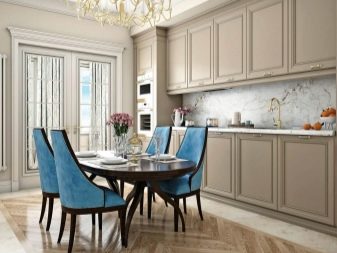
Style features
Neoclassicism for the kitchen is an unusual solution also because such a design is not suitable in every situation. If you describe the style in the most general terms, then it is usually called good old classics in a more modern version, however, the classics itself already imposes certain restrictions.
For example, a neoclassical interior necessarily assumes a significant amount of space, both to the sides and in height.




At the same time, neoclassical cuisine should not contain the slightest signs of cost savings - the result should look gorgeous, albeit without obvious frills, so you will have to stock up on money. The high cost is caused not only by some special decor, but also by the quality of the materials used - neoclassical repairs are not done for a couple of years. It is distinguished by its solidity and durability.
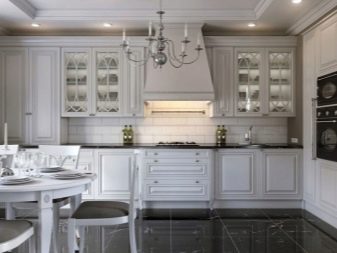



If we talk about distinctive features, then neoclassicism is characterized by a certain lightness and elegance, as well as the severity of proportions and straightforwardness of the situation - unnecessary rounding is inappropriate here. This style is not characterized by an abundance of decor, and if it is used, it is only rather limited and with a bias in Egyptian motifs. The color scheme is selected exquisitely; excessive loudness or dissonance of shades should not be noticeable.




The desired result can be achieved using various methods and materials, however, some of the latter are so incompatible in the public sense with luxury and chic that their use should be carefully avoided. These taboos include, for example, linoleum and hardboard. Plastic panels, like plastic in general, also seem inappropriately modern and somehow cheap, about the same can be said about LED lighting - neoclassicism wants huge chandeliers, not modest lights.
Open shelves also stand out from the general style: all containers for storing something must be closed, even if their view is possible thanks to the glass in the doors.

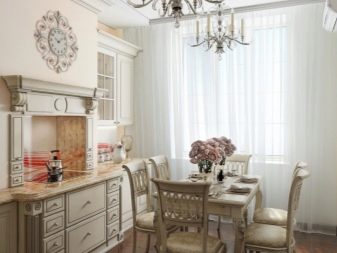

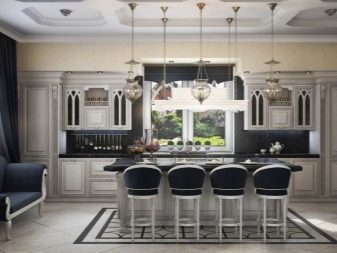
Due to the fact that neoclassical cuisine requires space, it is often in this style that the kitchen area in studios is decorated. The very organization of space leaves a central place for a large dining table, whose center position is reinforced by an expensive chandelier hanging directly above it. Depending on the square of the room, the headset is installed along the wall, and if the area allows, it is separated from the dining area by a specially purchased bar counter.




Finishes and colors
A neoclassical style kitchen involves significant restrictions in terms of the choice of design.Neoclassicism itself is not so picky and allows the use of different colors, however, for the kitchen, the excessive majesty of the dark finish is inappropriate, and the gray palette does not promote appetite, therefore the choice should always fall on light colors. If we talk about specific preferred shades, then beige and golden, light pink, fawn and pale blue tones are in maximum demand. Although pale shades of green, at first glance, would be a good addition to the palette, they are not used when creating neoclassical design, otherwise the interior acquires the property of sliding towards the country.
Among the combinations, the combination of ivory with mother-of-pearl is a success.




It should be noted that neoclassicism is a very expensive style, but its emphasized aristocracy is incompatible with the excessive luridness of colors. We can say that a certain proportion of the chicness of neoclassical cuisine is due to its rigor, therefore there is no place here not only for outstanding decor, but also for bright color accents, which, in one way or another, would dilute the strict stateliness of the design. If a too pale gamma still seems boring, you can "liven up" the primary colors a little, but they should not differ significantly from each other, because a noticeable contrast will ruin all the charm.




Interestingly, the neoclassical interior puts forward specific requirements for the material - it should not be wood, but stone or its various modern imitations. Of course, individual elements of furnishings or finishes may not fit into this rule, but at least the general tone must match.




There are also general rules for choosing finishes, according to which, for example, light-colored plaster is the best finish for walls and ceilings. However, they should not be exactly the same. - for the ceiling, choose an option lighter by two tones, which fully complies with the design rule about the absence of color accents. For an apron, tiles with geometric patterns or soft flowers (plants, not shades) are suitable. The use of wallpaper of any kind is not welcome, but mosaic or Venetian plaster will be very useful, because with their help you can bring the missing "stone" into the design.




For the floor, it is best to choose either a tile with a simple ornament, or just a plain one in two different colors, creating a checkerboard pattern. Of the alternatives, you can consider wooden flooring options that copy parquet or laminate, but any roll solutions will spoil the overall impression.
Interestingly, the floor is not so strictly tied to the general gamut, when choosing its shade, you can largely focus on your own preferences, although the emphasis on it, again, should not be done.




From artistic wall decorations, you can use classic elements such as friezes and pilasters, as well as semi-columns. A wide border under antique stucco molding turns out to be an almost indispensable element of neoclassical cuisine. Moreover, most of these decorations are not covered with any ornament at all, keeping in mind the necessary rigor of the design.




Furniture and decor
A kitchen set - the central object for most kitchens - in terms of design should follow the general trends, that is, it should have a light shade. As is the case with finishes, a dark palette is completely discouraged here, as are brighter accents, however there is one significant exception - a dining table can and often should even be made of relatively dark wood.
The contours of the furnishings remain strict and rectangular, they are performed only with a bevel, but certainly without any more complex decorations. Stained glass of furniture is permissible, but multicolored glass is prohibited - only classic transparent.There is no place in neoclassicism for antiques and modern curly furniture, although an antique sideboard can be placed in sight.




The neoclassical design cannot be considered complete until some important accessories are added to it. Table textiles in the form of tablecloths and napkins should directly declare their luxury and high cost, lace should be actively used in it. On the floor in the center, a place should be allocated for an exquisite fleecy carpet, it can be well combined with an island in the form of a bar counter, if one is provided.
Curtains are made of expensive fabric, and towels, sewn from another fabric, should ideally be in perfect harmony with them in shade. By the way, the curtains should hang on a wooden or metal cornice, which can even be decorated with floral patterns.




The overall luxury should be evident in the cutlery too - at least in the basic details. For example, sets should be as porcelain as possible, as was the case in true classic kitchens and dining rooms, and although they don't have to be monochromatic, their patterns shouldn't look too modern or out of place bright. Vases for flowers or fruits were an obligatory central element of a chic classic table, therefore, ideally, you should try to find, if not a real antique copy, then at least a skillful and believable imitation.
Naturally, such vases should not be empty.




Of course, simple wall decorations that have been tested for centuries can also be used. We are talking about various paintings, tapestries and panels, although their theme is usually advised to be limited exclusively to the kitchen and dining room. The final touch to the image of a neoclassical kitchen will be a wall clock - again, indeed, antique or high-quality imitation.



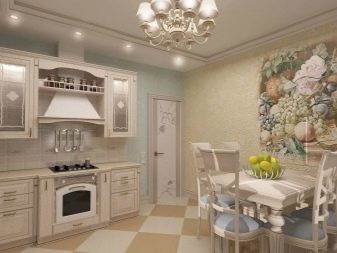
All of the above details can seem very difficult to implement and overly precise. In fact, a good and experienced designer may well deviate somewhat from the recommendations presented and create neoclassicism in a single kitchen without something specified and with something of his own.
Another thing is that neoclassicism is a stylistic direction, beyond which it is quite easy to go, and any careless movement can completely ruin the perception of the kitchen.




The finishing touch to the design will be light and lighting fixtures. Daylight in a neoclassical kitchen should not dazzle, penetrating into the room, it should become diffused and soft - for this purpose, dense curtains serve. As for electric light, its main source must necessarily be an expensive chandelier, ideally a wrought iron or crystal. The massiveness of this accessory should be worthy of kings, but it is important not to overdo it so that it does not turn into a bulky accent in a relatively cramped room.


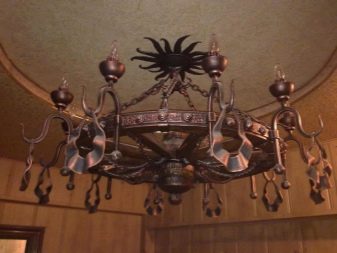

At the same time, the kitchen area should have its own lighting for the convenience of cooking - usually the issue is solved with the help of built-in spotlights, which are completely invisible when turned off. And although all of the above could well be enough for sufficient illumination of the territory, the needs of an exquisite design suggest that there should be more light - sconces and small lamps in the form of candles are used to complement the set, in some places floor lamps with large lampshades are appropriate, allowing additional zoning of the space.




Advice
The arrangement of the neoclassical kitchen as a whole has already been described in some detail above, and the only thing that is still not there is the answer to the question of how to arrange at least a relatively neoclassical room of a small area. Let's say right away that the same chic will hardly be felt, but it is still possible to achieve a certain result.




First of all, in a cramped kitchenette, planned for neoclassical design, the color palette is even more limited - only white and very close shades are appropriate here, because they allow you to visually increase the space. This applies to both decoration and furniture.
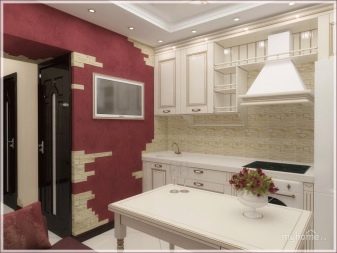



The whole environment should be as thoughtful and ergonomic as possible - in a cramped room it is unacceptable to further reduce the free space, cluttering it with furniture. Because of this, the kitchen may lose a little in functionality - unnecessary things will have to be removed from here, leaving only the most necessary. Everything that is left has the functionality to be at the highest level, roomy storage boxes and multi-tasking pieces of furniture are welcome.
But the decor and additional accessories for decoration are even less appropriate here than in a large kitchen - they will greatly attract attention, claiming to be an accent.




Beautiful examples of the interior
The first example is a good demonstration of why too dark tones in neoclassical kitchen finishes are usually not welcome. The table here is dark, as it should be, but the color scheme of the apron looks questionable - although the room cannot be denied in style, for many people it may seem too gloomy for eating. Black chandeliers complement the overall gloomy look for an amateur.

The second option, on the contrary, is a good confirmation that it is light shades that will save neoclassicism. There are practically no dark tones here - only the table differs in those, which in this case is the only permitted accent. I would like to pay special attention to the design of the floor, which here itself is a work of art and elegantly complements the rest of the interior.

The third photo is an example of neoclassicism, which lacks some chic, its essence is a more modest version. The floors here are made of wood, which can be quite expensive, but does not give the impression that the elaborate tiled flooring in the previous example left. Modest chandeliers, albeit in the number of three, are a touch that significantly impairs the perception of the zest of neoclassicism - chic.

For an overview of the neoclassical kitchen interior, see the video below.













The comment was sent successfully.